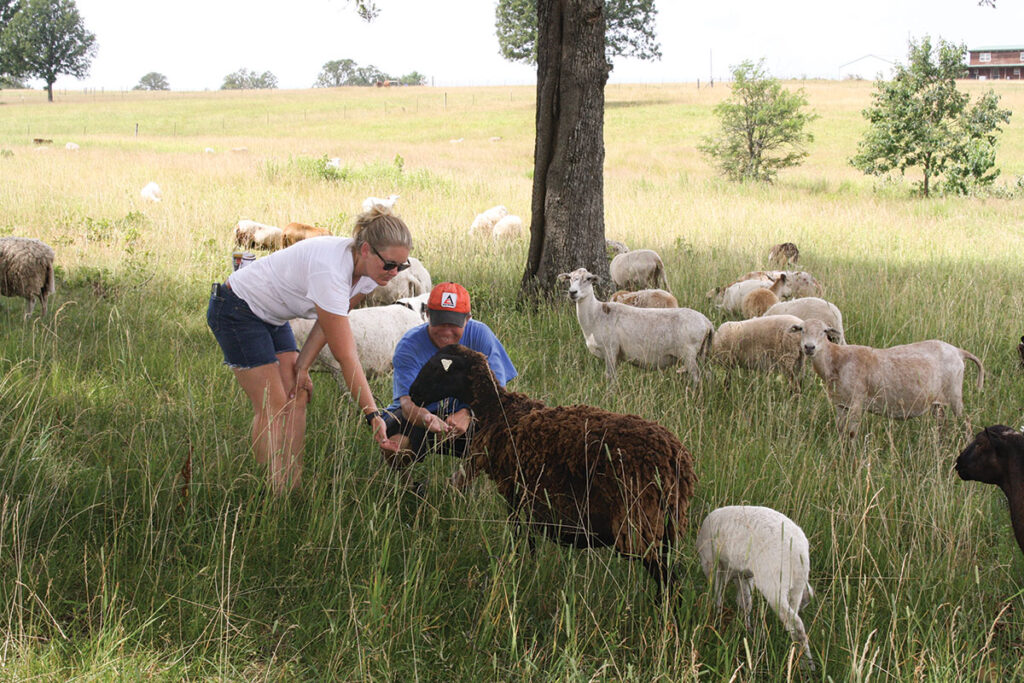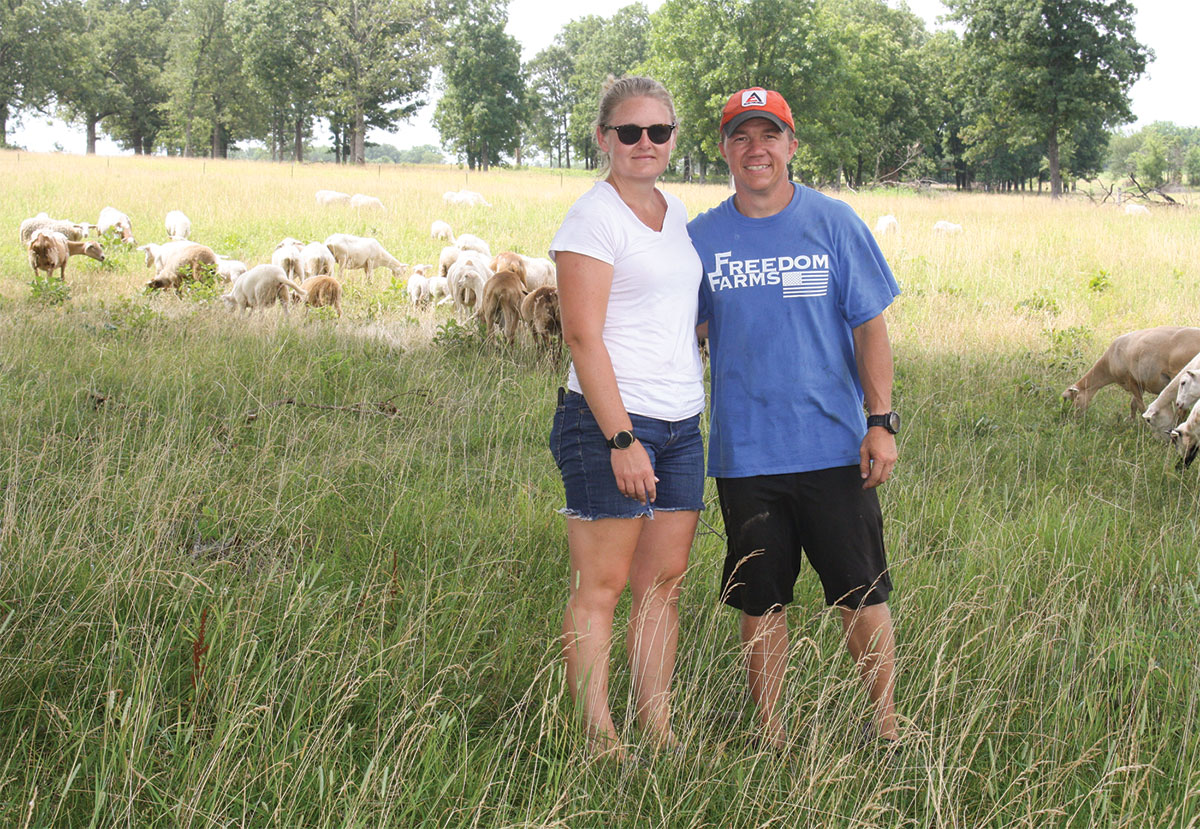
Travis and Chrissy Linden are working to grow and improve at Freedom Farms
ROBY, MO. – Illinois natives Travis and Chrissy Linden were brought to the Ozarks by Travis’ military career but soon decided it was the ideal place to put down roots for his retirement from active duty.
They purchased a 20-acre farm near Roby, Mo., in Texas County in 2013 with the hopes of raising cattle. They soon realized, however, that they didn’t have enough land. Instead, the couple opted for sheep. In 2017, they bought three Katahdin/Dorper crosses.
“We started with three, then bought 40 more,” Travis recalled, adding that their flock now exceeds 140 head with adult stock and lambs and consists of 77 acres.
With no experience with sheep, Travis and Chrissy said were some bumps in the road. They lost several sheep to parasites and other factors, but thanks to extensive research, they say the sheep at Freedom Farms are happy and healthy, and death loss is nearly non-existent.
“It was all from not understanding what we should have done,” Travis said.
Travis and Chrissy opted to go with the initial Katahdin/Dorper cross because that was what was available. They like the size of the Dorper, and twinning and parasite resistance of the Katahdin. Currently, they have moved toward Katahdin rams for easier lambing and twins.
Going with a haired breed of sheep was ideal for the family, including children Cheyenne, 11, and Gage, 9, because they require fewer labor inputs. Because Travis is still a member of the U.S. Army, and Chrissy works full-time, things at Freedom Farms must be as easy as possible.
“The more minimal, the better,” Chrissy said.
“We would have to hire someone to shear them, and you might break even with the wool,” Travis added. “You aren’t going to make money off wool, and it has to come off.”
The couple said some of their sheep tend to be a little “wooly” and do not shed well. Those animals are typically culled from the flock.
“We don’t want to breed that back in,” Chrissy said.
Other culling factors are troublesome feet and legs, a lack of maternal traits, a record of only producing singles, and being problematic with parasites.
“If they have problems in these conditions, they are gone,” Travis said. “It really doesn’t get much better than this. Typically, the rams we bring in have to be dewormed, but that cycle is quickly broken.”
The couple prefers a natural approach to breeding, allowing rams to remain with the flock. They currently have a 20-to-1 ewe to ram ratio.
“We don’t do accelerated lambing,” Travis explained, adding the ewes are not given any medication or extra feed to stimulate the breeding cycle. “We let them breed back on their own.”
During lambing season, from Dec. 15 to March 15, ewes are brought to a recently constructed lambing barn, which also has access to a paddock to lamb. Some lambs, however, are born outside the scheduled lambing season.
“The downside is that the prime market is in April,” Travis said. “You get your best money because the grass is coming on, and there are big holidays that help drive up the prices.”
To help them grow the flock, the family retains most of their ewe lambs, and rams are switched yearly. New rams are in place by June.
Breeding occurs naturally, as does weaning.
“We’ve tried both ways,” Chrissy explained. “The lambs grow better if the moms naturally wean them.”
However, ram lambs are pulled from the main flock at about six months of age and go into a separate pasture before being sold as meat animals.
The flock is pasture-based, with access to supplements at all times. The flock is rotated to a new pasture every five days. The rotational program allows for the lifecycle of any parasites to be broken and ample recovery time before being grazed again, usually about two months.
“It has significantly cut down the need to deworm,” Chrissy said, who attended a USDA grazing school. “We haven’t had to worm anything in two years.”
“When we were trying to keep the sheep in one paddock, we were constantly having problems,” Travis added. “This is so much easier because we come open a gate every five days, move their water and mineral. It takes very little time, and the benefits are tremendous because you aren’t chasing them down to deworm them.”
The rotational program also allows the sheep to bring natural fertilizer to the paddocks and have improved the forages found on the farm.
“The grasses have changed dramatically just from their presence,” Travis said. “This is all grass. The pH level of the sheep manure is higher than any other ruminant being grass-fed. That brings up the pH of the soil, which pushes some of the weeds that tend to thrive in low pH soils out. It’s so thick; it’s hard to walk through.”
The couple said areas of their paddock system that had little or no grass are now lush, and thanks to the rotational program, the flock is not short of grass during current hot, dry conditions.

“We haven’t had to do anything,” Travis said of the forages in the grazing system. “I know a lot of people like to do intensive grazing, but we don’t force them to eat anything. The reason being, if you force them to eat, they are going to eat down low.”
While the paddock system has improved forages, the family has battled sericea lespedeza and has begun chemical eradication.
The goal of Freedom Farms is to increase the flock to 350 head, and thanks to their rotational grazing program, Travis and Chrissy said their forages would be ample to continue a grass-fed program.
“We want to be at that point in a couple of years,” Chrissy said. “We typically get a 40-60 split on ram and ewe lambs.”
Ram lambs are sold off the farm or through a local livestock market. Once their flock reaches the 350-mark, they may consider selling commercial replacement ewes.
The Lindens produce their own hay and have found the sheep manure removed from their lambing barn has favorable results when used as fertilizer.
“We put it on the areas of the hayfield that we knew were low producing, and we averaged the highest numbers yet,” Travis said.
Travis has calculated that it requires one-third of a 5-by-5 round bale to feed a ewe and her lambs in the winter months. The couple has also constructed hay feeders for their barn that reduce waste by utilizing smaller holes for the sheep to pull hay from.
The Freedom Farms flock is a closed flock, with only new rams coming in.
“I know it’s unpopular, but we don’t give a CDT (Clostridium Perfringens Types C & D – Tetanus Toxoid) vaccination anymore,” Travis said. “The ones we do bring in are from a trusted flock that we bought our first 40 from. They vaccinate, so I know they are vaccinated when they come here. It’s not the cost; we simply didn’t think it is needed.”
The Lindens said they have no death loss in connection with disease.
The family enjoys being part of a community, which is another reason they moved to the Ozarks. They help out the neighbors when needed, and their neighbors return that favor. They all work together to put up hay, work animals, or anything else that needs to be done.
“It’s funny how different the operations are,” Travis said of his neighbors’ cattle farms. “But we all have the same goal of animals eating grass and gaining weight.”
Being new farmers, the Lindens wanted to share their path to becoming livestock producers and started their own YouTube channel, chronicling their life on the farm and how they have built their program.
“We’ve noticed people see those big farms on YouTube and think, ‘Man, that’s the kind of farm I want,’” Travis said. “Not everyone can be a fifth-generation farmer, but everyone can be a first-generation farmer. I don’t think people realize they can start a farm, but you have to want it and put a lot of effort into it.”







